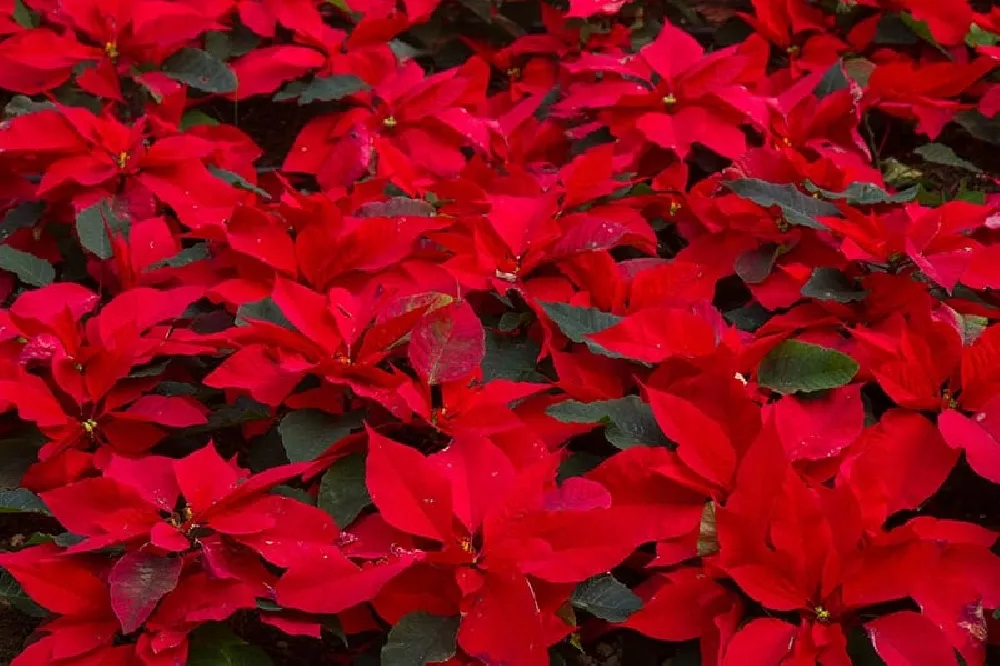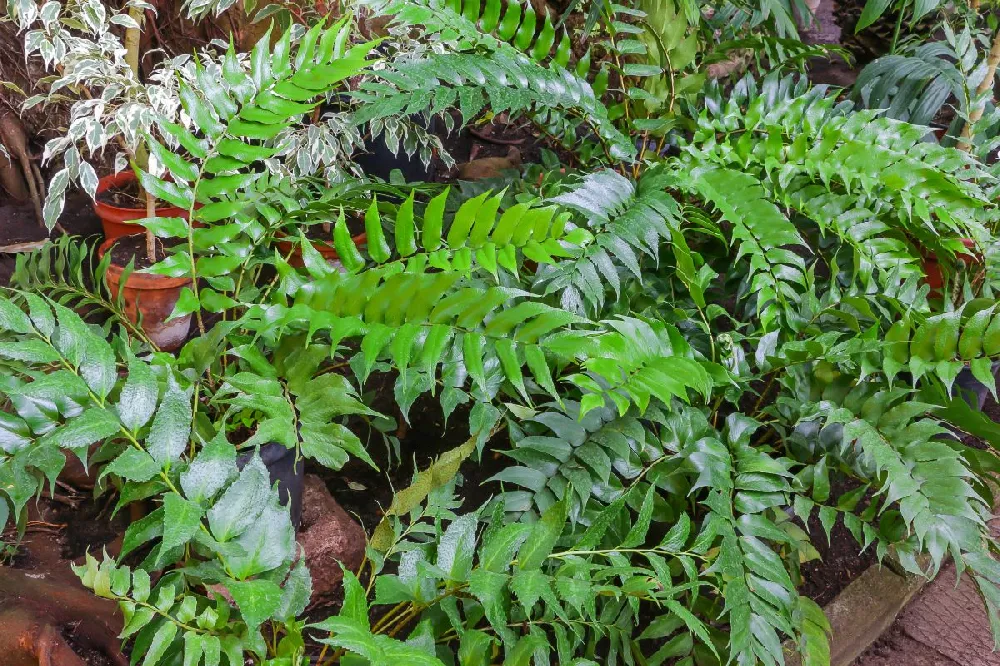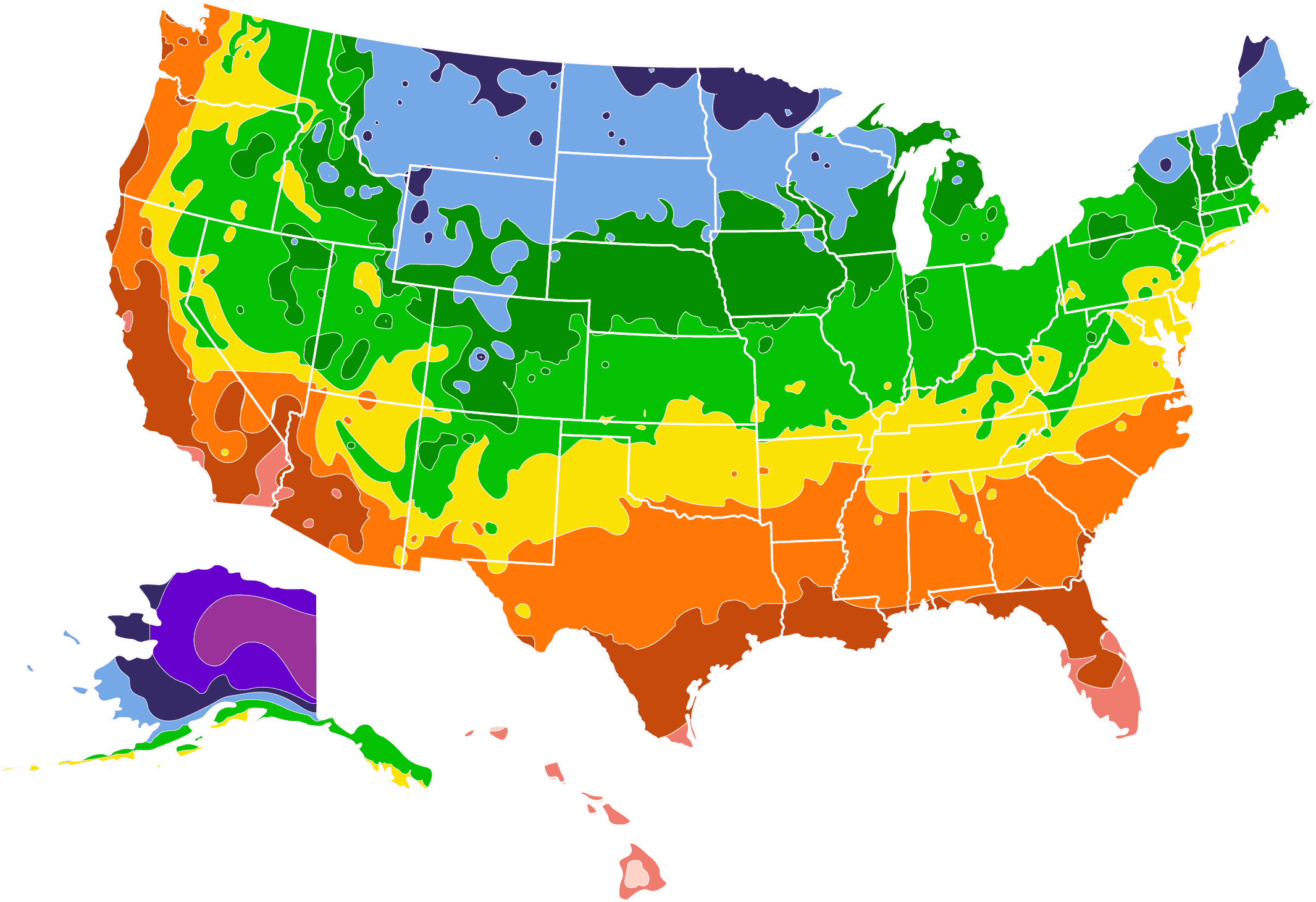- Home >
- Ornamental Plants >
- Poinsettias
Poinsettias for Sale - Buying & Growing Guide
Lowe’s - 2-Quart - Blue Poinsettia in Pot
Enter your zip code to find nearby stores that may carry this plant.
The brilliant scarlet leafs of the poinsettia are commonly associated with the Christmas season, but the plant has a life outside of holidays. In fact, it is a tropical perennial native to Mexico and Central America, and with the right care and climate, it can become part of your outdoor landscape or take a place among your favorite indoor houseplants. Here are some other notable facts about poinsettias:
- Form tiny and yellow flowers.
- Can grow to the height of small trees in warm climates.
- Most are red, but they’ve also been bred to turn white, pink, orange, light green, and variegated patterns of red and white.
Planting and Care
Planting instructions
Poinsettias can grow outdoors in gardens in USDA hardiness zones 9, 10, and 11. They require daytime temperatures that are consistently between 65 and 80 degrees Fahrenheit and nighttime temperatures no lower than 60 degrees Fahrenheit.
Poinsettia plants are generally sold in nurseries between Thanksgiving and New Year’s Eve, and if you want to add one to your garden or your indoor collection, that is the time to purchase them. If you live in a climate where temperatures never fall to frost levels, they are easy plants to grow. However, cold climate gardeners will need to invest a significant amount of attention to keep it healthy throughout the year and blooming at holiday time.
To keep a poinsettia indoors throughout the year, you need to find a warm spot not subject to drafts, preferably with plenty of direct sunlight. Your poinsettia is happiest between 65 and 70 degrees Fahrenheit during the day and no colder than 55 or 60 degrees Fahrenheit at night. The plant should be watered when the surface of the soil feels dry, but you need to make sure that your pot has good drainage to make sure that the roots do not get too saturated.
An indoor poinsettia should be allowed to dry out in April. Take it out of the bright light and put it in a spot that is a bit cooler, around 60 degrees Fahrenheit, and water should be sparse, only giving it enough to keep the stem healthy. That stem should then be pruned to just 4 inches high in May and then the plant should be moved to a warmer, sunny spot again, repotting if it seems rootbound and beginning to water it regularly again. The plant will start issuing new leaves, at which point it should be fertilized every two weeks.
Growing a Poinsettia is significantly easier if you live in a warm-weather climate and can plant it in your garden after the holidays are over. To get maximum enjoyment from keeping it indoors, water it when the soil begins to dry and place it in an area where it gets direct sun and stays warm.
Watering and nutrients
Poinsettias need to be watered when their soil surface dries out, and there is a fine line between overwatering and underwatering. Make sure that your plant has drainage holes and that water is draining out, and if it is wrapped in decorative foil, remove the foil so that the roots do not sit in water and become saturated. To keep your plant throughout the year, it will need a period of dormancy where it is allowed to dry out and lose its leaves before watering is resumed and leaves begin to emerge again.
Poinsettia plants need peat-based soil with organic material mixed in and should be fertilized using a water-soluble fertilizer every other week or slow-release pellets in the spring. Fertilizer should be provided from late spring until the holidays.
Pruning
Poinsettia pruning has two purposes. The first is to help the plant regroup after its heavy blooming season and the second is to keep its shape attractive. In late spring or early winter, the stems should be cut back to just four inches, leaving only one or two leaves on each one and then allowing the plant to dry out in preparation for its growing season. After the weather turns warm and new growth begins to emerge, tips of stems should be pinched off whenever there are more than three or four leaves on a branch. Doing this every month will encourage a bushy shape. Stop pruning leaves off after early fall.
Pests, diseases, and animals
Poinsettias are vulnerable to fungal diseases of both their leaves and their roots. Botrytis blight, also known as gray mold, and powdery mildew are particularly prevalent. Fungicides can help if the issue is caught early. Roots and crowns can develop blackened areas that end up causing the plants to collapse. In most cases, plants will need to be thrown out if facing one of these infections. To prevent fungal disease, make sure that the soil is kept moist but not waterlogged, and do not fertilize when the plants are flowering.
The colorful plants are also subject to damage from insects including fungus gnat larvae, which attack the roots, and whiteflies, which suck the fluid from the undersides of the poinsettia’s leaves and leave a sticky fluid behind that invites mold. Insecticide can address both. If you find scarring and distortion on your plant’s leaves, the culprit is likely the western flower thrip, which will also respond to insecticidal soap or horticultural oil.
Light
These plants are accustomed to life in Central America, where they enjoy a lot of sun, so you need to recreate this environment in your home to allow the plant to thrive. A windowsill is usually a good spot for a poinsettia, though make sure it is not allowed to come into contact with the window pane itself, as these can get very cold during the winter months.
If your windows are not well insulated, you may be better off positioning the plant on a well-lit table in your living room. It will enjoy being in the brightest spot your home can offer, providing it is warm enough.
These plants can be quite particular about where they are kept, so if you feel like your poinsettia isn’t thriving in its current position, then don’t be shy about moving it and trying out a different spot until you find one your plant is happy with.
Temperature
Poinsettias should be kept at a constant temperature of between 65 and 75 °F during the winter months to give them the best chance of staying in bloom. As typical room temperature usually sits at around 70 °F, any living space in your home should be a comfortable temperature for the plant.
The exception to this is anywhere that the plant could be subject to cold drafts. Never place it in an entryway or near a window that gets opened. Also, take care if you position the plant on a windowsill, because if the window panes get cold and the plant comes into contact with the window, then it will likely sustain some damage.
Some people keep their poinsettias on a window sill but move them to a table or somewhere more central in a room each night. This is because if the window gets cold, then the plant could get too cold overnight, especially if it is hidden behind a drawn curtain and doesn’t benefit from heating in the home. The lowest temperature the plant should be subjected to overnight is 60 °F. Any lower than this, and you will likely notice some leaves shriveling and dropping.
Humidity
As a native of the tropics, the poinsettia thrives in humid conditions. Humidity in homes is typically very low in the winter, as home heating systems have a tendency to dry out the air. This can be easily remedied to keep your poinsettia happy, and you have a few options you can choose from to achieve increased humidity.
One option is to simply mist the plants with a water spray every day. Another option is to sit the plant on a pebble tray and fill over the pebbles with water. As the water evaporates, the humidity around the plant is increased.
You could also do this without the use of a tray if your plant is housed in a larger plant pot for aesthetic purposes. Set some pebbles at the bottom of the exterior pot and cover with water before sitting the poinsettias own pot on top of them.
For both a pebble tray or pebbles in a pot, always ensure that the water level is lower than the tallest pebble. This will prevent any water from being absorbed by the plant’s soil through its drainage holes, as this could result in soggy roots and a sickly plant. Another option is to use an electric humidifier to increase humidity in your entire room or home.
Propagation
Poinsettias can be propagated from seeds or stem cuttings. To harvest seeds from your poinsettia, take them from your parent’s plant as soon as the seeds start to turn brown. Dry them out by placing them in a paper bag and setting them aside. When the seeds have burst out of their pods, then they are ready to be planted.
Poinsettia seeds are easy to sow; they can simply be placed on moist soil and covered with a light layer of more soil. Set them in a warm shaded spot, maintain moist soil, and wait for germination to take place. Though poinsettia seeds take little effort to propagate, they may not produce a plant the same as the parent plant. The only way to ensure this is with stem cuttings.
To propagate with a stem cutting, you will need to take a cutting from the plant of between 3 and 4 inches in late spring or summer. To give yourself the best chances of success, you will need a stem from new growth. Old stems that have had the colored leaf bracts already growing on them will not work well for this.
Dip the cut end of your stems in rooting hormone before inserting them in moist potting soil. They should be kept in a bright position but away from direct sunlight. They will grow well in a greenhouse, or you could put a clear plastic bag over the cutting to help increase humidity and recreate a greenhouse environment.
Once new growth appears on your cutting, you should remove the plastic bag, and after a few weeks, move the stem cutting to a larger pot. Keep the new plants in a bright spot until the fall when you will need to induce flowering by providing the poinsettias with long dark nights (New Mexico State University Cooperative Extension).
Reblooming
If you are able to provide the conditions the poinsettia requires, you shouldn’t find it too difficult to keep the plant blooming and healthy for a few months through the festive season. However, getting it to rebloom the following winter can take some effort. This typically begins in April. Follow these monthly guidelines to help your poinsettia bloom next year.
January, February, and March
Continue care as normal, watering the plant whenever the surface of the soil is dry to the touch.
April
Gradually dry out the plant by cutting back on watering, allowing a few days of dry soil before you water it again, and slowly increasing the length of time the soil spends dry between each watering.
If the stem begins to shrivel, then you have dried out the plant too quickly, and it is stressed and will die. This needs to be a gradual process so as not to shock the poinsettia. A few weeks into the drying process, transport the plant to a cool area, such as a basement. It should be kept at around 60 °F.
May
Now, your plant needs to be pruned. Cut it back to around 4 inches tall and repot it. Use a pot slightly larger than its previous pot and fill the bottom with new potting soil. Gently remove the plant from its original pot so as not to disrupt the roots and set it down in the new pot.
Fill around the root ball with more new potting soil, ensuring that the bottom of the stem sits at the same level as it did in the previous pot. Water the plant generously and move it back to its previous home in a warm and bright spot. Water the plant as you previously would have, adding water every time the surface of the soil is dry.
Once you spot new growth appearing on the plant, you should begin fertilizing it. Use a balanced liquid fertilizer at half the recommended strength once a month. All of the new growth will be green, and this is completely normal.
June
At this point, you can continue to grow your poinsettia as a houseplant in the brightest spot in your home, or you can move the plant outside for the summer. If you move it outside, select a partially shaded spot for the plant, ideally one that gets plenty of morning sunlight but is sheltered from the strong heat of the afternoon.
Continue with your usual watering and fertilizing schedule, noting that a plant kept outdoors may have need to be watered more frequently than if kept indoors. Poinsettias are actually grown as shrubs in their natural habitat and are hardy through USDA growing zones 10 to 12. If you live in one of these warmer zones, you can plant your poinsettia directly in the ground and grow it as a shrub.
July
At the beginning of July, the poinsettia will need to be lightly pruned. Do this by trimming back each stem by about an inch. This will encourage bushier growth with plenty of branching. If you see a poinsettia that has become tall and leggy, it is usually because this vital pruning has been neglected.
August
During August, the poinsettia should have nicely branched out and have plenty of new growth. Once again, prune the plant back, pinching the stems so that around four leaves are left on each. At the end of August, if your plant spent the summer outside, you can now bring it back indoors. Position it in a bright window and continue the usual maintenance.
September and October
Continue usual care until the last week of September or the first week of October, then begin a period of forced darkness for the plant. Poinsettias need between 8 and 10 weeks of short days, meaning total darkness for 14 or 15 hours overnight during this time. These short days are vital for the poinsettias to rebloom because their buds are affected by light.
The best way to manufacture these short days required by the plant is to move the plant to a dark spot at around 5 pm each day, bringing it back out at 8 am each morning to its usual bright spot. Some people put the plant in a disused room, such as a spare bedroom, and keep the curtains closed. Other people move the plant to a cupboard overnight.
Remember that a temperature of no lower than 60 °F needs to be maintained, so moving the plant to a garage or dark basement is not an option, and if you move the plant to a disused room, make sure it is heated.
The slightest bit of light during the dark nights will negatively affect the plant, delaying blooming, or preventing it altogether. If kept in a cupboard, it is wise to put a blanket over the plant so that if anyone opens the cupboard during the night, then it won’t be subjected to light.
Streetlights through a window or the soft glow of a nightlight will also affect the plant’s ability to bloom, so try your best to remove all chances of light getting to the plant during its overnight hours. Otherwise, all of your efforts to get the plant to rebloom may have been in vain.
November and December
By the middle to the end of November, the plant should have had a sufficient amount of short days and can now be permanently brought back to its usual bright spot. If all has gone well, the poinsettia should have developed its red leaf bracts, and flower buds should be forming on the plant by this time.
Continue usual care throughout the winter, and enjoy reaping the rewards of all your hard work!
Poinsettia Varieties

Classic Red

This is the poinsettia most people are familiar with. It features solid vibrant red leaf bracts at the top of the plant, with deep green leaves on the lower half of the plant. Its flowers are green-yellow.
Euphorbia Christmas Beauty Marble

The leaf bracts of this plant are striking in highly pigmented pink with a marbled pattern in luscious cream.
Euphorbia pulcherrima ‘Freedom Jingle Bells’

This unusual poinsettia is a real show stopper. It has glossy green leaves, complemented by ‘petals’ in a two-tone pattern with bright red and buttery yellow. It has an incredibly festive look that makes an excellent Christmas centerpiece.
Polly’s Pink

This poinsettia has green leaves and deep pink leaf bracts. This plant is a great way to bring pretty, vibrant colors to a wintery room.
Winter Rose Dark Red

This plant has burgundy leaves, which look incredibly dramatic next to its lower green leaves. It is an especially festive-looking poinsettia and would be perfect for a Christmas centerpiece.
Princettia Max White
This delicate-looking plant has creamy white bracts that have baby pink veins running through them, giving it a pretty and elegant look.
Euphorbia Envy
This poinsettia has vivid lime green ‘petals,’ which grow in an upward direction to make an interesting-looking plant. It seems to be a little sturdier than some other poinsettias and is less likely to succumb to an early death than more traditional varieties. It typically lasts longer than red-leafed poinsettias.
Polar Bear
As you might expect from the name of this variety, its leaves are pure white. Unlike most poinsettias, it only has one leaf color, so if you are a fan of consistent-looking plants, then this would be a good choice. It also works well alongside more traditional poinsettias, providing a nice contrast.
Strawberries and Cream
This poinsettia has pale pink leaves that have darker pink veins running through them. If your Christmas color scheme is less traditional, and you are moving away from all things red, this is a pretty plant to give a festive vibe with a modern edge. The lower leaves of this plant are medium green, which contrasts nicely against the soft pink shades above.
FAQs
Are poinsettia poisonous to humans or animals?
Though many people believe that poinsettias are poisonous, ingesting them will lead to nothing more than a stomachache. They are safe to have around the house, though owners should take care when handling any broken stems or leaves, as they release a sap that can lead to an itchy rash. If you cannot wear gloves when pruning or handling a poinsettia, make sure that you do not touch your eyes before you are able to wash your hands.
I left my poinsettia in the car and it seems to have frozen. What can I do?
Poinsettias are extremely sensitive to the cold, and exposing them to temperatures under 50 degrees Fahrenheit can kill them. If your plant loses all of its leaves then it is completely dead, but if there are leaves left try trimming off damaged areas and placing the plant in a bright spot with indirect light and temperatures between 65 and 75 degrees Fahrenheit with no drafts. Water it every few days to keep the soil moist, then take it outside once the weather turns warm. If your efforts have been successful, it will begin to send out new leaves in the summer.















